A) they fear retaliation in the form of pricing wars from the natural monopolist.
B) they are unsure of the size of the market in general.
C) they know they cannot achieve the same low costs that the natural monopolist enjoys.
D) the natural monopoly does not make a large profit.
F) None of the above
Correct Answer

verified
Correct Answer
verified
Multiple Choice
Figure 15-3 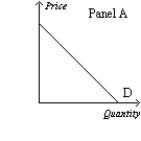

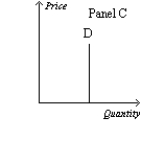
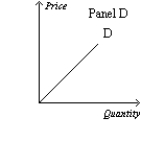 -Refer to Figure 15-3. Which panel could represent the demand curve facing the soybean industry?
-Refer to Figure 15-3. Which panel could represent the demand curve facing the soybean industry?
A) Panel A
B) Panel B
C) Panel C
D) Panel D
F) A) and C)
Correct Answer

verified
Correct Answer
verified
True/False
A monopoly creates a deadweight loss to society because it earns both short-run and long-run positive economic profits.
B) False
Correct Answer

verified
Correct Answer
verified
Short Answer
Figure 15-2 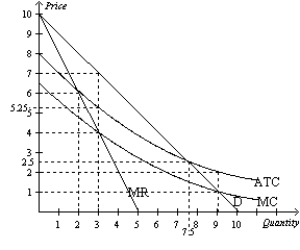 -Refer to Figure 15-2. If a regulator requires the firm to charge an average cost price, what is the amount of profit or loss earned by the firm?
-Refer to Figure 15-2. If a regulator requires the firm to charge an average cost price, what is the amount of profit or loss earned by the firm?
Correct Answer

verified
Correct Answer
verified
Multiple Choice
Patent and copyright laws encourage
A) creative activity.
B) lower prices due to decreasing average total costs.
C) competition among firms.
D) All of the above are correct.
F) A) and C)
Correct Answer

verified
Correct Answer
verified
Multiple Choice
Which of the following is not a characteristic of a monopoly?
A) barriers to entry
B) one seller
C) one buyer
D) a product without close substitutes
F) None of the above
Correct Answer

verified
Correct Answer
verified
True/False
If the ABC company owns the exclusive rights to mine land in Afghanistan for Lapis Lazuli, a rare stone used in jewelry which is found only in Afghanistan, the company benefits from a barrier to entry.
B) False
Correct Answer

verified
Correct Answer
verified
True/False
A natural monopoly will always operate in the region of the long run average total cost curve where the cost per unit is constant.
B) False
Correct Answer

verified
Correct Answer
verified
Multiple Choice
If government officials break up a natural monopoly into four smaller firms, then
A) each firm will be unable to maximize profits due to increased competition.
B) competition will force firms to produce surplus output, which drives up price.
C) the average cost of production will increase.
D) consumers will benefit from lower average total costs.
F) A) and D)
Correct Answer

verified
Correct Answer
verified
True/False
A monopolist's supply curve is vertical.
B) False
Correct Answer

verified
Correct Answer
verified
Multiple Choice
Monopoly pricing prevents some mutually beneficial trades from taking place. These unrealized, mutually beneficial trades are
A) not a concern if a market is perfectly competitive.
B) a deadweight loss to society.
C) a function of the reduction in the quantity produced by a monopolist in comparison to a competitive market.
D) All of the above are correct.
F) A) and B)
Correct Answer

verified
Correct Answer
verified
Multiple Choice
Figure 15-19 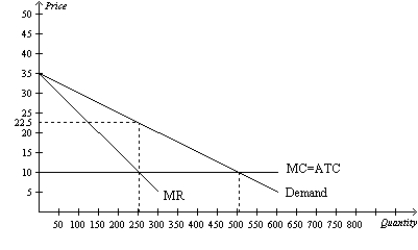 -Refer to Figure 15-19. If there are no fixed costs of production, monopoly profit with perfect price discrimination equals
-Refer to Figure 15-19. If there are no fixed costs of production, monopoly profit with perfect price discrimination equals
A) $1.
B) $1,562.5.
C) $3,125.
D) $6,250.
F) A) and C)
Correct Answer

verified
Correct Answer
verified
Short Answer
Microsoft's government-granted exclusive right to make and sell the Windows operating system is called a
Correct Answer

verified
Correct Answer
verified
Multiple Choice
Price discrimination explains why Ivy League universities often base tuition costs on students'
A) age.
B) financial resources.
C) high school GPA.
D) gender.
F) A) and C)
Correct Answer

verified
Correct Answer
verified
Multiple Choice
Figure 15-19  -Refer to Figure 15-19. If the monopoly firm is not allowed to price discriminate, then consumer surplus amounts to
-Refer to Figure 15-19. If the monopoly firm is not allowed to price discriminate, then consumer surplus amounts to
A) $0.
B) $1,562.50.
C) $3,125.
D) $6,250.
F) None of the above
Correct Answer

verified
Correct Answer
verified
True/False
In order for a firm to maximize profits through price discrimination, the firm must have some market power and be able to prevent arbitrage.
B) False
Correct Answer

verified
Correct Answer
verified
Multiple Choice
Table 15-21
Tommy's Tie Company, a monopolist, has the following cost and revenue information. Assume that Tommy's is able to engage in perfect price discrimination. 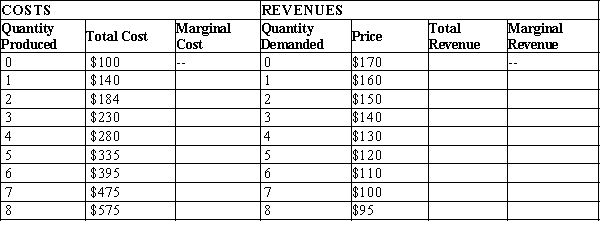 -Refer to Table 15-21. If the monopolist can engage in perfect price discrimination, what is total profit at the profit-maximizing quantity?
-Refer to Table 15-21. If the monopolist can engage in perfect price discrimination, what is total profit at the profit-maximizing quantity?
A) $325
B) $435
C) $565
D) $1000
F) B) and C)
Correct Answer

verified
Correct Answer
verified
Multiple Choice
If the government regulates the price that a natural monopolist can charge to be equal to the firm's average total cost, the firm will
A) earn zero profits.
B) earn positive profits, causing other firms to enter the industry.
C) earn negative profits, causing the firm to exit the industry.
D) minimize costs in order to lower the price that it charges.
F) B) and C)
Correct Answer

verified
Correct Answer
verified
Multiple Choice
A movie theater can increase its profits through price discrimination by charging a higher price to adults and a lower price to children if
A) adults buy more popcorn than children.
B) the cost of showing a movie to children is less than the cost of showing a movie to adults.
C) it has some degree of monopoly-pricing power.
D) All of the above are correct.
F) B) and C)
Correct Answer

verified
Correct Answer
verified
Multiple Choice
Granting a pharmaceutical company a patent for a new medicine will lead to (i) A product that is priced higher than it would be without the exclusive rights. (ii) Incentives for pharmaceutical companies to invest in research and development. (iii) Higher quantities of output than without the patent.
A) (i) and (ii) only
B) (ii) and (iii) only
C) (i) and (iii) only
D) (i) , (ii) , and (iii)
F) All of the above
Correct Answer

verified
Correct Answer
verified
Showing 601 - 620 of 662
Related Exams